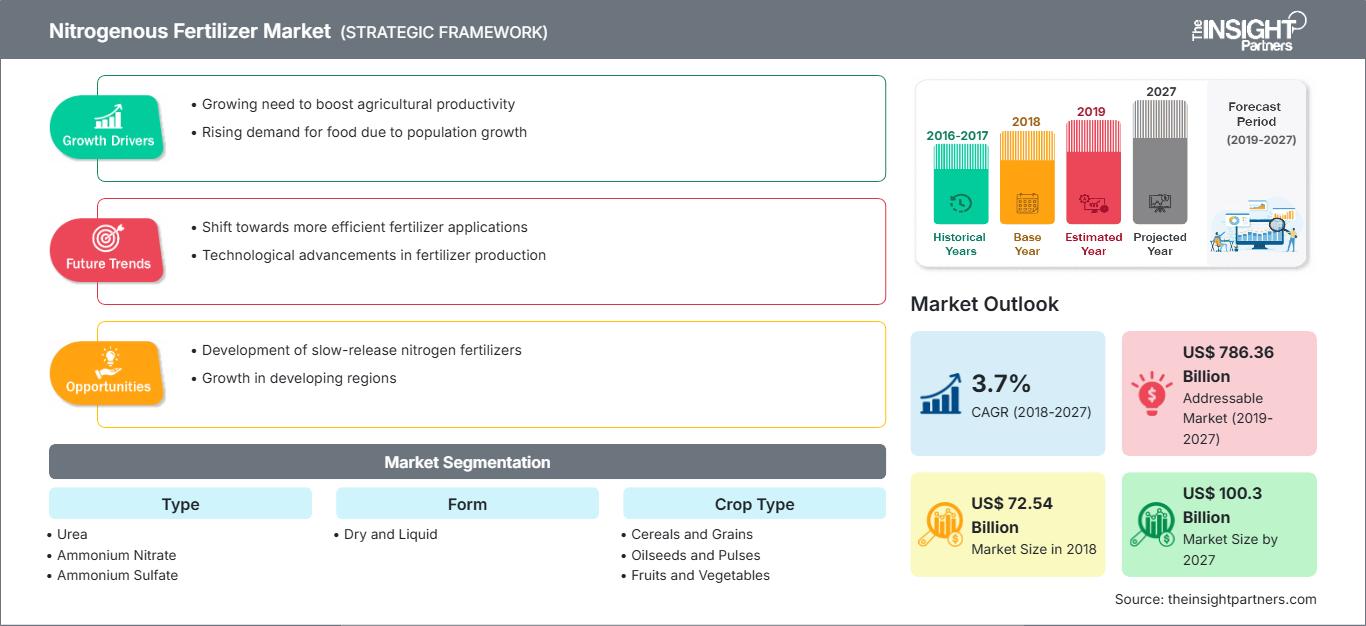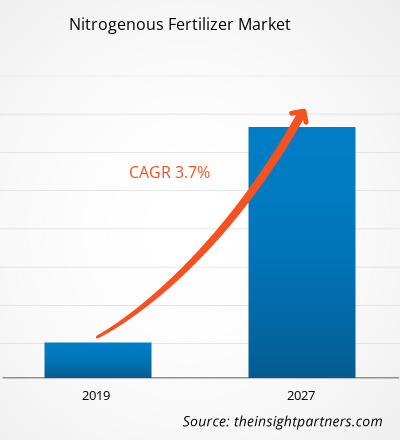Il mercato dei fertilizzanti azotati è stato valutato a 72.537,57 milioni di dollari nel 2018 e si prevede che crescerà a un CAGR del 3,7% dal 2019 al 2027, raggiungendo i 100.304,42 milioni di dollari entro il 2027.
Il fertilizzante azotato viene prodotto utilizzando l'azoto presente nell'aria e sottoposto a una complessa reazione chimica. L'azoto viene utilizzato per promuovere la crescita delle colture e conferisce alle piante una consistenza e un colore migliori, contribuendo così a migliorare la produttività agricola. Il processo Haber Bosch è considerato la tecnica più utilizzata per la produzione di fertilizzanti azotati. Il gas naturale è una delle materie prime più importanti, utilizzata nel processo Haber Bosch insieme ad altre forme di materie prime come letame animale e compost, tra le altre. L'aumento della popolazione ha fatto aumentare la domanda di sicurezza alimentare e, di conseguenza, la necessità di utilizzare tali fertilizzanti per apportare nutrienti essenziali al suolo, migliorandone la qualità e, in ultima analisi, portando a rese più elevate.
Si prevede che il mercato dei fertilizzanti azotati in Nord America crescerà al CAGR più elevato durante il periodo di previsione. Il Nord America è il mercato in più rapida crescita per i fertilizzanti azotati, grazie all'aumento delle applicazioni di fertilizzanti azotati, supportato da misure governative positive a sostegno della crescita del settore. Inoltre, l'aumento del reddito disponibile, abbinato a maggiori investimenti in strutture agricole migliori, probabilmente stimolerà la domanda di fertilizzanti azotati nel mercato nordamericano. Tuttavia, i rischi per l'ambiente e la salute derivanti dall'uso di tali fertilizzanti sintetici hanno portato a un maggiore utilizzo di prodotti agricoli biologici. Ciò potrebbe ostacolare la crescita del mercato dei fertilizzanti azotati.
Personalizza questo rapporto in base alle tue esigenze
Potrai personalizzare gratuitamente qualsiasi rapporto, comprese parti di questo rapporto, o analisi a livello di paese, pacchetto dati Excel, oltre a usufruire di grandi offerte e sconti per start-up e università
Mercato dei fertilizzanti azotati: Approfondimenti strategici

-
Ottieni le principali tendenze chiave del mercato di questo rapporto.Questo campione GRATUITO includerà l'analisi dei dati, che vanno dalle tendenze di mercato alle stime e alle previsioni.
L'agricoltura commerciale è fondamentalmente definita come la coltivazione di colture per la vendita dei prodotti a scopo di lucro sul mercato interno o all'esportazione. L'agricoltura commerciale si è riformata e ha avviato una graduale evoluzione nel settore agricolo. L'aumento della popolazione, unito all'impiego di tecnologie avanzate e di infrastrutture più efficienti, ha avuto un impatto positivo sulla crescita dell'agricoltura commerciale. Gli sviluppi nel settore agricolo hanno gettato le basi per l'adozione di tecnologie e l'impiego di fertilizzanti di alta qualità per aumentare la resa, come i fertilizzanti azotati. Pertanto, la crescita dell'agricoltura commerciale comporterebbe un ulteriore aumento della domanda di fertilizzanti azotati. Ad esempio, l'introduzione e l'uso di urea rivestita, insieme all'aumento della domanda di fertilizzanti con miscele di N, P e K e all'adozione di fertilizzanti rivestiti con lievito, hanno acquisito importanza nel settore agricolo per migliorare la fertilità del suolo. Attualmente, la maggior parte delle aziende agricole impiega macchinari avanzati e tecnologie sofisticate. Ad esempio, l'uso di sensori del suolo e droni è diventato una parte essenziale dell'agricoltura su larga scala e si prevede che l'agricoltura verticale farà passi da gigante grazie alla raccolta senza l'uso della luce solare o del suolo.
Approfondimenti sui prodotti
In base all'applicazione, è segmentato in urea, nitrato di ammonio, solfato di ammonio, ammoniaca, nitrato di calcio e ammonio e altri. Il segmento dell'urea ha rappresentato la quota maggiore del mercato globale nel 2018, mentre si prevede che il mercato del solfato di ammonio crescerà al CAGR più elevato durante il periodo di previsione. Una delle prime fonti di azoto solido prodotte su larga scala è il nitrato di ammonio. Il fertilizzante a base di nitrato di ammonio è molto volatile, il che lo rende utile in settori specifici. Il nitrato di ammonio è un sale cristallino quasi incolore e inodore. L'applicazione di nitrato di ammonio in giardini e campi agricoli su larga scala migliora la crescita delle piante e fornisce un apporto di azoto da cui le piante possono attingere. Il fertilizzante a base di nitrato di ammonio è un composto semplice da produrre. Si produce quando l'ammoniaca gassosa reagisce con l'acido nitrico. La reazione chimica forma una formula concentrata di nitrato di ammonio, che produce enormi quantità di calore. Come fertilizzante, il composto viene distribuito in granuli e fuso con solfato di ammonio per ridurne la volatilità.
Approfondimenti applicativi
In base al tipo di coltura, è segmentato in cereali e granaglie, semi oleosi e legumi, frutta e verdura e altri. Il segmento dei cereali e granaglie ha rappresentato la quota maggiore del mercato nel 2018, mentre si prevede che il segmento dei semi oleosi e dei legumi registrerà il CAGR più elevato durante il periodo di previsione. Tutte le colture di semi oleosi e legumi richiedono azoto in quantità moderatamente elevate. L'azoto è il nutriente più limitante nella produzione di semi oleosi e legumi in tutto il mondo. Le colture normalmente assorbono la maggior parte dell'azoto dal terreno sotto forma di azoto nitrico. Quando i livelli di azoto nel terreno sono adeguati, l'azoto favorisce una crescita dinamica e una maggiore superficie fogliare con un colore verde scuro. L'analisi del terreno è molto utile per stimare il fabbisogno di fertilizzanti azotati. La crescente domanda di oli e legumi in tutto il mondo è stata uno dei principali fattori che hanno contribuito all'espansione dei fertilizzanti azotati. La crescente propensione delle persone verso uno stile di vita sano ha favorito un aumento del consumo di semi oleosi e legumi, grazie ai loro benefici per la salute. Tutti questi fattori hanno quindi alimentato la domanda del mercato dei fertilizzanti azotati e contribuito all'espansione del mercato in tutto il mondo.
Alcuni operatori che operano nel mercato dei fertilizzanti azotati sono Bunge Limited, CF Industries Holdings, Inc., EuroChem Group, Koch Fertilizer, Llc, Nutrien Ltd. e OCI Nitrogen. Le aziende chiave implementano fusioni e acquisizioni e strategie di ricerca e sviluppo per espandere la base clienti e ottenere una quota significativa nel mercato globale, il che consente loro anche di mantenere il proprio marchio a livello globale.
In evidenza nel rapporto
- Tendenze progressive del settore nel mercato dei fertilizzanti azotati per aiutare gli operatori a sviluppare strategie efficaci a lungo termine
- Strategie di crescita aziendale adottate dai mercati sviluppati e in via di sviluppo
- Analisi quantitativa del mercato dei fertilizzanti azotati dal 2019 al 2027
- Stima della domanda globale di fertilizzanti azotati
- Analisi PEST per illustrare l'efficacia di acquirenti e fornitori che operano nel settore
- Sviluppi recenti per comprendere lo scenario competitivo del mercato
- Tendenze e prospettive di mercato, nonché fattori che guidano e frenano la crescita del mercato dei fertilizzanti azotati
- Assistenza nel processo decisionale evidenziando le strategie di mercato che sostengono l'interesse commerciale, portando alla crescita del mercato
- Dimensioni del mercato dei fertilizzanti azotati in vari nodi
- Panoramica dettagliata e segmentazione del mercato, nonché dinamiche del settore dei fertilizzanti azotati
- Dimensioni del mercato dei fertilizzanti azotati in varie regioni con promettenti opportunità di crescita
Approfondimenti regionali sul mercato dei fertilizzanti azotati
Le tendenze regionali e i fattori che influenzano il mercato dei fertilizzanti azotati durante il periodo di previsione sono stati ampiamente spiegati dagli analisti di The Insight Partners. Questa sezione analizza anche i segmenti e la geografia del mercato dei fertilizzanti azotati in Nord America, Europa, Asia-Pacifico, Medio Oriente e Africa, America meridionale e centrale.
Ambito del rapporto sul mercato dei fertilizzanti azotati
| Attributo del rapporto | Dettagli |
|---|---|
| Dimensioni del mercato in 2018 | US$ 72.54 Billion |
| Dimensioni del mercato per 2027 | US$ 100.3 Billion |
| CAGR globale (2018 - 2027) | 3.7% |
| Dati storici | 2016-2017 |
| Periodo di previsione | 2019-2027 |
| Segmenti coperti |
By Tipo
|
| Regioni e paesi coperti |
Nord America
|
| Leader di mercato e profili aziendali chiave |
|
Densità degli operatori del mercato dei fertilizzanti azotati: comprendere il suo impatto sulle dinamiche aziendali
Il mercato dei fertilizzanti azotati è in rapida crescita, trainato dalla crescente domanda degli utenti finali, dovuta a fattori quali l'evoluzione delle preferenze dei consumatori, i progressi tecnologici e una maggiore consapevolezza dei benefici del prodotto. Con l'aumento della domanda, le aziende stanno ampliando la propria offerta, innovando per soddisfare le esigenze dei consumatori e sfruttando le tendenze emergenti, alimentando ulteriormente la crescita del mercato.

- Ottieni il Mercato dei fertilizzanti azotati Panoramica dei principali attori chiave
Mercato dei fertilizzanti azotati - per tipo
- Urea
- Nitrato di ammonio
- Solfato di ammonio
- Ammoniaca
- Nitrato di ammonio di calcio
- Altri
Mercato dei fertilizzanti azotati - per forma
- Secco
- Liquido
Mercato dei fertilizzanti azotati - per tipo per tipo di coltura
- Cereali e granaglie
- Semi oleosi e legumi
- Frutta e verdura
- Altro
Profili aziendali
- Bunge Limited
- CF Industries Holdings, Inc.
- EuroChem Group
- Koch Fertilizer, Llc
- Nutrien Ltd.
- OCI Nitrogen
- SABIC Group
- Sinofert
- TOGLIATTIAZOT (TOAZ)
- Yara International ASA
- Analisi storica (2 anni), anno base, previsione (7 anni) con CAGR
- Analisi PEST e SWOT
- Valore/volume delle dimensioni del mercato - Globale, Regionale, Nazionale
- Industria e panorama competitivo
- Set di dati Excel
Report recenti
Rapporti correlati
Testimonianze
Motivo dell'acquisto
- Processo decisionale informato
- Comprensione delle dinamiche di mercato
- Analisi competitiva
- Analisi dei clienti
- Previsioni di mercato
- Mitigazione del rischio
- Pianificazione strategica
- Giustificazione degli investimenti
- Identificazione dei mercati emergenti
- Miglioramento delle strategie di marketing
- Aumento dell'efficienza operativa
- Allineamento alle tendenze normative






















 Ottieni un campione gratuito per - Mercato dei fertilizzanti azotati
Ottieni un campione gratuito per - Mercato dei fertilizzanti azotati